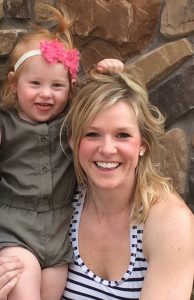 As a personal trainer at Life Time Athletic in Vadnais Heights, Laura Susla is focused every day on health and wellness. Perhaps that’s why when she received several “signs” that it was time to get back to the dermatologist for a skin screening, she paid attention.
As a personal trainer at Life Time Athletic in Vadnais Heights, Laura Susla is focused every day on health and wellness. Perhaps that’s why when she received several “signs” that it was time to get back to the dermatologist for a skin screening, she paid attention.
“During a routine physical my doctor recommended I go for a screening, since I have a lot of moles. Since my mom has had melanoma as well as other skin cancers, I had screenings in the past but hadn’t been to the dermatologist in a while,” Laura says. Then, several clients were diagnosed with skin cancer and Laura knew she needed to book an appointment for a skin screening as soon as possible.
Two suspicious moles were spotted by Dr. Phillip Keith during Laura’s appointment at our Vadnais Heights office and after biopsies were done, she was diagnosed with two invasive melanomas. Laura had two surgeries to remove lesions on her back and shoulder. Each surgery left her unable to work for two weeks due to the depth of the incision.
“I was definitely shocked at the diagnosis,” says Laura. “We had a pool growing up and I did visit tanning booths when I was younger, but I never thought I would be diagnosed with cancer at 31.” Like most parents, Laura wondered what could have happened to her daughter Avery, just 2, if she hadn’t gone in to see Dr. Keith and the cancer had advanced.
“People with multiple atypical moles, such as large moles with irregular shapes, color variations and other characteristics, can have an increased risk of melanoma,” says Dr. Keith. “Individuals with numerous atypical moles, a family history of melanoma or a history of using tanning beds use should have a skin cancer screening exam. Unfortunately, the incidence of skin cancer is rising in young adults, especially women.”
Melanoma is a more serious form of skin cancer that can spread from the skin to other tissues and organs. Known risk factors for developing melanoma include a fair or light complexion, a family history of melanoma, sun exposure and sunburns, including tanning beds and a weakened immune system. However melanoma and other skin cancers can develop in anyone not only people with these risk factors. Young, healthy people—even those with dark skin, hair, and eyes—can develop melanoma.
“Since being diagnosed with melanoma, I’ve become much more proactive about sun protection. My daughter has red hair, and we use long sleeves, hats, as well as clothing and swimsuits with SPF to protect her skin from the sun,” Laura says.
Laura has also convinced several of her co-workers to go for screening since her cancer diagnosis. Laura remains clear of melanoma but will visit Dr. Keith for regular scans every 3 months for the next year, and every six months for five years after that.




